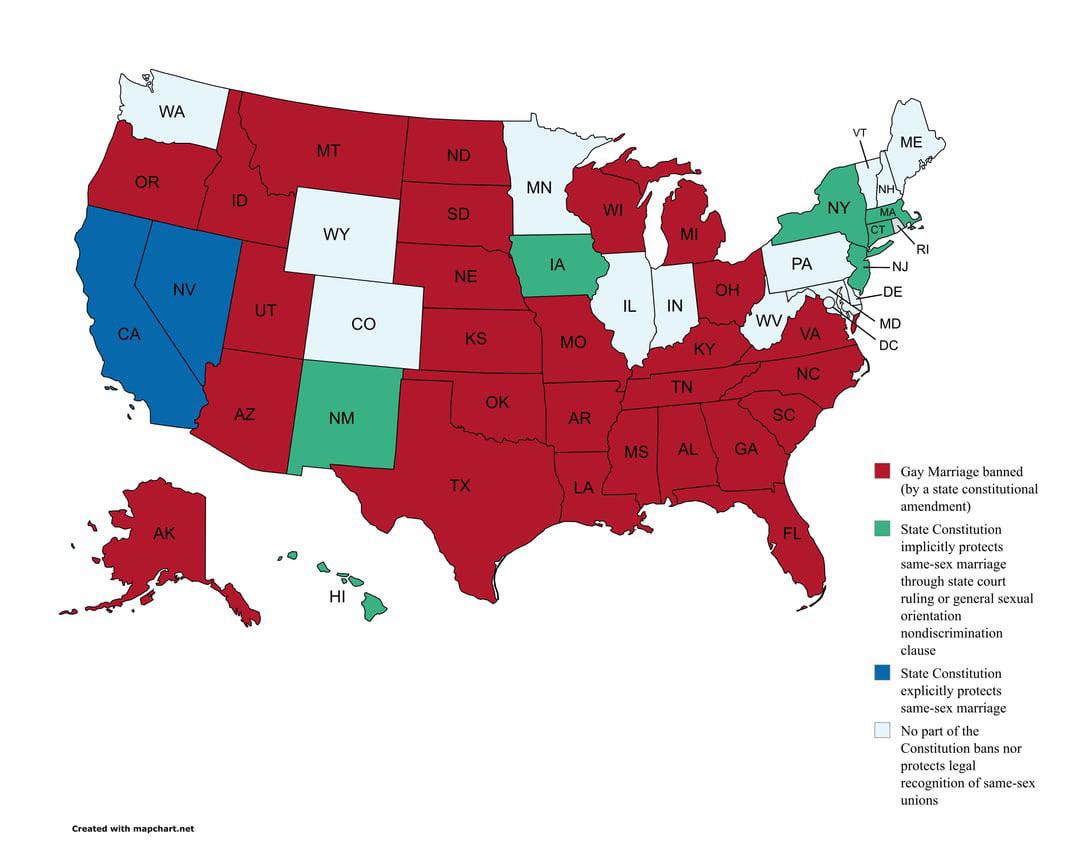Map of USA Same Sex Marriage Protections in State Constitutions


Alex Cartwright
Senior Cartographer & GIS Specialist
Alex Cartwright is a renowned cartographer and geographic information systems specialist with over 15 years of experience in spatial analysis and data...
Geographic Analysis
What This Map Shows
This map provides a clear visualization of the current status of same-sex marriage protections across the United States, focusing specifically on the states that have constitutional amendments in place banning same-sex marriage. Although these amendments were rendered invalid by the landmark Obergefell v. Hodges decision in June 2015, which legalized same-sex marriage nationwide, the historical context of these amendments remains crucial in understanding the ongoing discussions surrounding LGBTQ+ rights in America. This map serves as a reminder of the legal battles that have shaped the landscape of marriage equality and highlights the states that once held these prohibitive measures in their constitutions.
Deep Dive into Same-Sex Marriage Constitutional Amendments
Same-sex marriage has been a contentious issue in the United States for decades. The constitutional amendments banning same-sex marriage were adopted by various states primarily in the early 2000s, a period characterized by fierce debates and social movements advocating for LGBTQ+ rights. At the peak of this movement, over 30 states had passed such amendments, reflecting a significant societal divide on the issue.
Interestingly, these amendments often arose from fears that legalizing same-sex marriage would undermine traditional family structures. While many argued for the sanctity of marriage as a union between a man and a woman, others championed the need for equality and love to be recognized by the state, regardless of gender. The amendments varied in language and legal implications, but they all shared the common goal of barring same-sex couples from marrying legally.
The Obergefell decision not only invalidated these state amendments but also underscored the evolving perception of marriage and civil rights in the U.S. Interestingly, as of today, states like California, New York, and Massachusetts, which were among the first to legalize same-sex marriage, now stand as bastions of LGBTQ+ rights, while states that once had constitutional bans are now slowly shifting towards recognizing these rights, albeit not uniformly.
The legal landscape surrounding marriage equality is dynamic. While Obergefell provided a federal baseline for same-sex marriage rights, certain states still exhibit resistance in other legal areas, such as adoption rights and anti-discrimination laws. As of 2023, discussions continue on how to protect and expand these rights, particularly in regions where conservative ideologies prevail.
Regional Analysis
Breaking down the map regionally reveals significant contrasts in attitudes and legal frameworks surrounding same-sex marriage. In the Midwest, for example, states like Iowa and Illinois have embraced marriage equality, while states such as Ohio and Indiana still reflect a more conservative stance historically, evidenced by the presence of constitutional bans prior to the Obergefell ruling.
In the South, states like Florida and Virginia have made strides toward LGBTQ+ acceptance, but states like Alabama and Mississippi still grapple with stronger conservative ideologies reflected in their legal frameworks. The implications of these amendments can be seen in the social fabric of these states, where the LGBTQ+ community has often faced challenges that extend beyond marriage, including issues of healthcare access and anti-discrimination protections.
On the West Coast, states such as Oregon and Washington have not only legalized same-sex marriage but have also implemented robust protections for LGBTQ+ individuals, showcasing a progressive trend that is often lacking in other parts of the country. In contrast, states in the Northeast, like Massachusetts, were pioneers in legalizing same-sex marriage, leading the way for others to follow and setting a precedent for national acceptance.
Significance and Impact
Understanding the history and context of same-sex marriage protections is vital, as it highlights the ongoing struggle for civil rights and social justice in the United States. The journey from constitutional amendments banning same-sex marriage to nationwide legalization through the Obergefell decision reflects broader societal changes regarding gender and sexual identity.
What’s fascinating is that even though these amendments are no longer valid, their legacy lingers in the form of continued advocacy for comprehensive anti-discrimination laws and protections against hate crimes targeting the LGBTQ+ community. As public opinion continues to evolve, the map serves as a historical marker of where we have been and a reminder of the work that still lies ahead.
In recent years, there has been an increasing push for legislation to ensure that the rights established by Obergefell are not only preserved but expanded. As we look to the future, it is crucial to remain vigilant and proactive in defending these rights against potential rollbacks and to advocate for inclusivity and equality for all individuals, regardless of their sexual orientation. The journey toward full acceptance and legal protection continues, and maps like this one are essential in understanding both the progress made and the challenges that remain.
Visualization Details
- Published
- August 12, 2025
- Views
- 166
Comments
Loading comments...